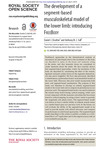Please use this identifier to cite or link to this item:
http://lib.hpu.edu.vn/handle/123456789/22391Full metadata record
| DC Field | Value | Language |
|---|---|---|
| dc.contributor.author | Cleather, Daniel J. | en_US |
| dc.contributor.author | Bull, Anthony M. J. | en_US |
| dc.date.accessioned | 2016-07-30T01:39:19Z | |
| dc.date.available | 2016-07-30T01:39:19Z | |
| dc.date.issued | 2015 | en_US |
| dc.identifier.other | HPU4160495 | en_US |
| dc.identifier.uri | https://lib.hpu.edu.vn/handle/123456789/22391 | en_US |
| dc.description.abstract | Traditional approaches to the biomechanical analysis of movement are joint-based that is the mechanics of the body are described in terms of the forces and moments acting at the joints, and that muscular forces are considered to create moments about the joints. We have recently shown that segment-based approaches, where the mechanics of the body are described by considering the effect of the muscle, ligament and joint contact forces on the segments themselves, can also prove insightful. | en_US |
| dc.format.extent | 17 p. | en_US |
| dc.format.mimetype | application/pdf | en_US |
| dc.language.iso | en | en_US |
| dc.subject | Engineering | en_US |
| dc.subject | Bioengineering | en_US |
| dc.subject | Biomechanics | en_US |
| dc.title | The development of a segment based musculoskeletal model of the lower limb | en_US |
| dc.type | Article | en_US |
| dc.size | 668KB | en_US |
| dc.department | Education | en_US |
| Appears in Collections: | Education | |
Files in This Item:
| File | Description | Size | Format | |
|---|---|---|---|---|
| 0378_Thedevelopmentofasegment.pdf Restricted Access | 668.42 kB | Adobe PDF |  View/Open Request a copy |
Items in DSpace are protected by copyright, with all rights reserved, unless otherwise indicated.
